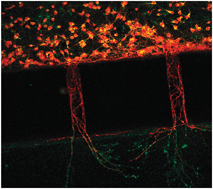Study of Na+/H+ exchange-mediated pHi regulations in neuronal soma and neurites in compartmentalized microfluidic devices†
Abstract

* Corresponding authors
a
Dept. of Neurological Surgery, University of Wisconsin Medical School, T513 Waisman Center, 1500 Highland Ave., Madison, USA
E-mail:
sun@neurosurg.wisc.edu
Fax: +1 (608) 263-1409
Tel: +1 (608) 263-4060
b Dept. of Neuroscience Training Program, Madison, USA
c Dept. of Physiology, School of Medicine and Public Health, Waisman Center, Madison, USA
d Dept. of Biomedical Engineering, Univ. of Wisconsin, Madison, USA

 Please wait while we load your content...
Something went wrong. Try again?
Please wait while we load your content...
Something went wrong. Try again?
 Fetching data from CrossRef.
Fetching data from CrossRef.
This may take some time to load.
Loading related content
